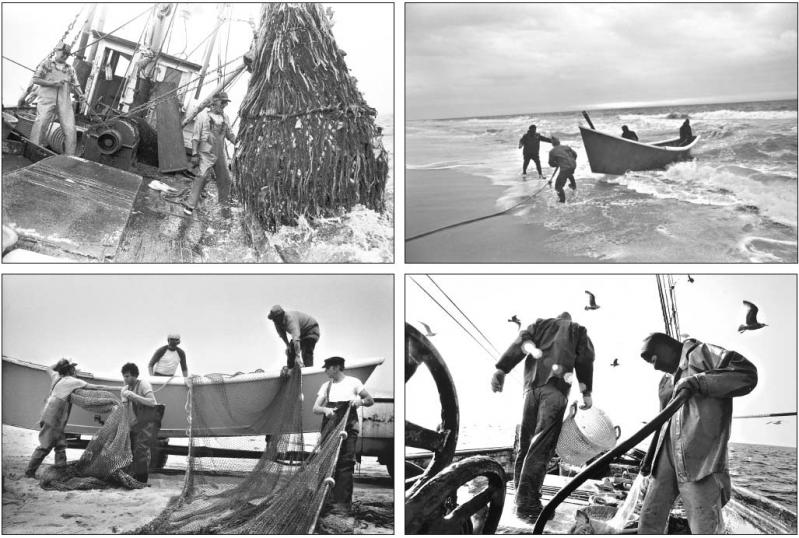Back in the 1980s, when Peter Matthiessen wrote the text to accompany the photographs in "Men's Lives," there were only about 100 full-time baymen on the South Fork. The book, published in 1986, was a kind of epitaph written for a way of life that was threatened and already well into its decline.
By 1990, haul-seine fishing was banned entirely by New York State, which was pressured by sportfishermen who maintained that that way of fishing was a threat to the striped bass population. But quotas and other restrictions had already taken a toll by that point. The book's photographs of the families and crews that plied the trade, intentionally black and white, caught the subjects as they were in the midst of their own history.
Stepping into Clinton Academy for "The Finest Kind," an exhibition featuring reprints of some of those photos mounted on foam core or a similar backing, one feels the funerary aspect of the project viscerally. The quiet reverence of the installation and the openness of the gallery space in this context make it feel like a chapel in the 18th-century East Hampton Village building, as if candles might be burning in an anteroom.
Experiencing the space with Doug Kuntz, for whom the show is a tribute, and who is the photographer for several of the images on view as well as a former fisherman who knew well so many of those pictured, is something else indeed. Mr. Kuntz is credited in the foreword of "Men's Lives" for coming up with the idea for the book, which Adelaide de Menil took on as a cause and brought to life with her stewardship and financial investment.
"This was so hard to work on," he recalled as he leafed through the volumes of "Men's Lives" placed on a pedestal in the gallery. "It was like writing your own obituary for five years," he said, his voice catching. As he walked through the display, he noted that "everyone in most of these pictures is dead." He found a few people who are still alive, but the stories of the dead were often heartbreaking. Two people in the photographs had committed suicide by shooting themselves. "They'd had enough," he said.
While Matthiessen's text has become legend, along with its recreation of the patois of the Bonackers, Mr. Kuntz had his own stories to tell. These were highly personal memories of people he grew up with, who often fed and housed him. They were also people he fished with, working for big bass hauls that would line their pockets with cash and might stave off winter's privations.
Mr. Kuntz shared a story he said he had not told many people, about the day his life changed, eventually resulting in an idea he had percolated for years being suddenly brought to fruition. He was hanging out on Timmy Reutershan's porch with some other friends on a Sunday morning. The two were friends from high school. "I think we were 22 years old. We're all hungover. Into Timmy's driveway pulls this woman, her name was Ruth Tischman, and Timmy tried to run, because he knew he was in trouble."
She was married to Paul Tischman of the New York real estate family. "They lived on Briar Patch Road in one of the most beautiful houses. They had serious money and were serious people," he said. She had come over "to yell at Timmy for not mowing her lawn."
She took a look at the young men gathered there and asked what they did with their time. One of them responded, "Oh, we drink a lot." She "just looked at us and said, 'That's really no way to live. You have to do something with your lives.' "
She asked them all if they could do anything they wanted in the town they grew up in and where they still lived, what would it be? Mr. Kuntz recalled that the rest of them didn't really have an answer, but he told her he would teach a photography class at the high school. She said that sounded interesting and took his phone number.
"The next day, I get a phone call. She says, 'I want you to come to New York City and meet some friends of mine.' " One of those friends was Adelaide de Menil. They all wanted to help him achieve his vision by funding the position and making sure he could teach under the guidance of the art teacher.
After a year, the money ran out, and he stopped teaching. Ms. de Menil called him to find out what happened and what he was doing. He told her he was at work on a book "about the fishermen I've been working with out here, all of my life." She asked him to send her a proposal. He stayed up all night writing one so he could send it off the next day.
In a week, they were sitting down to discuss how it could be done. She offered him the money he said he needed for it, if she could hire a writer and a few more photographers to help him. "She was really into photography, a huge collector. She took photographs herself. And I knew she was serious."
He had heard of some of the photographers she mentioned, names like Danny Lyon and Martine Franck, who was the second wife of Henri Cartier-Bresson. (Mr. Kuntz said Cartier-Bresson joined his wife in East Hampton while she was shooting, but was already fairly old and weak at the time.)
Mr. Kuntz agreed to the offer, and soon Ms. de Menil's connections and bountiful budget were easing the way. At the end of the project, she gave the East Hampton Town Marine Museum the prints that are hanging in Clinton Academy today.
This brings us back to the exhibition, which may be followed by a show of Mr. Kuntz's more recent work sharing similar themes, likely combined with some of his work from "The Finest Kind," sometime in March.

William Havens's name comes up a lot in these conversations. "He was like a father to me," Mr. Kuntz said. Havens told him that when he was a child, decades ago, "if he didn't have 100 pounds of potatoes" in the basement, "come fall or winter, there could be trouble. People would go hungry." Bass fishing might have been profitable, but it was no guarantee of financial stability. "Things were rough back then," Mr. Kuntz acknowledged.
He recalled that he first encountered the family when Floyd Havens, Willam's brother, was dating his mother. He "walked into my bedroom once, I was in fourth grade . . . and he goes, 'Get up, boy, wanna go fishing?' " Mr. Kuntz said. "And I just got up, it was something to do, and that was it. I never looked back. It wasn't like fishing with a rod and reel, like a little guppy. It was truckloads of fish. It was pretty much the real deal."
He not only fished with the Havenses, but he learned from them how to take photographs of what they were doing. "I might be taking a picture of a boat, and [William would] say, 'Get down lower, boy, because the waves will look bigger.' These guys taught me more about photography than anyone."
He remembers when things started to change. There were suddenly more people and tourists on the beach in the 1970s and 1980s. The fishermen used to have the beaches mostly to themselves. They would put out their nets and could catch thousands of pounds of fish. When people started seeing the amount being brought in, it wasn't a good look. And about the same time, the sportfishermen were pressuring the state to step in and limit the catch.
"I mean, it had been going on for three generations, and all of a sudden it's wrong?" Mr. Kuntz said.
The nets were set in semicircles with trucks pulling on either end. They would drive closer together in order to gather fish in the middle. He pointed out Francis Lester in a photo and said one day he was driving and his net caught on a woman's ankle bracelet, dragging her about 10 feet down the beach. She wasn't hurt and he didn't get in trouble, but "that's when we said, 'Oh, there's going to be a problem here.' "
Only recently did the Marine Museum take out the photos to organize and clean them. There are many others not on view. In 1983, the photos were mounted to be shown in Albany to begin a conversation between fishermen and scientists about reforming bass law. It then went to the Schellinger House in Amagansett during the summer of 1984 before becoming part of the museum's archive. Other shows of prints from the series were mounted all over Europe and North America.
These versions of the photos have barely been seen in the 40 years that have passed. Mr. Kuntz said the opening had children and grandchildren finding relatives in the images.
"It was another, totally different world. It's gone now." He noted the headline of the review of "Men's Lives" in The New York Times Book Review: "This Is the Way a World Ends."
"But you know, it might be gone, but this is here," he said, tapping the book with a knuckle and looking around at the walls.




